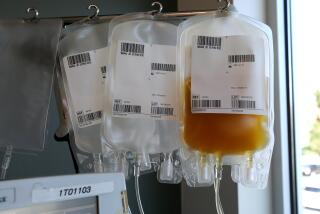The Cutting Edge: COMPUTING / TECHNOLOGY / INNOVATION : Plasma Treatment Makes Money Last
- Share via
Making money last is not just a problem for holiday shoppers. The U.S. Department of the Treasury’s Bureau of Engraving and Printing would like paper currency to stay in circulationlonger. Along with a major overhaul of the design of U.S. currency next year, the Treasury hopes to improve its quality. A study led by Raymond A. Young, a University of Wisconsin at Madison forestry professor, has found a way to stretch the wallet-life of the greenback. The main problem with aging bills is the tendency of ink to fade or wear off. The Madison study found that treating currency paper with gaseous materials known as plasmas not only significantly improved the paper’s ability to absorb and hold ink, but did not produce any visible changes on the surface of the paper.
Plasma-aided manufacturing involves the use of electrically charged particles to produce new materials with unusual and superior properties. The plasmas are formed by adding a gas to an electrical field, which causes the gas molecules to split apart and form radically new compounds. The process is already used in a number of ways, including treating automobile parts to improve the adhesion of paint and for etching more precise semiconductors.
The researchers tried out three different gases--oxygen, silicon tetrachloride and carbon tetrafluoride--for the currency-treating plasma. The first two gases worked fine. Unfortunately, the carbon tetrafluoride created a Teflon-like coating, making the paper totally impenetrable to ink. The Treasury hopes that plasma-treated currency paper will not only last longer, but might help foil counterfeiters too.
Do You See What I See: In the classic Japanese film “Rashomon,” viewers grapple with the question of why the characters remember different and often mutually exclusive details about the same scene. Neuroscientists have also wrestled with this question. And a new study published by researchers from the University of California at Davis, and Otto von Guericke Technical College in Magdenburg, Germany, provides at least a partial answer.
The team found that the way an individual brain registers and processes visual information depends on where the person was directing his attention. Paying attention to one part of a complex scene effectively boosts those visual brain signals while weakening signals from other parts of the scene. This selective attention keeps us focused on the most important items at the moment--say, the road ahead when we’re driving--but may cause us to miss a stop sign on the side of the road.
The study showed that selective attention kicks in as fast as 80 milliseconds after the retina at the back of the eyeball sends an exact copy of the visual world to the brain for processing. The selected images receive enhanced visual processing. The results of the study are important in efforts to eventually diagnose and treat neurological diseases and disorders. But they may also have practical applications for human performance. Airplane cockpits, for example, are already designed to incorporate knowledge about where we focus attention. A better understanding of selective attention would help prevent perceptual failures during the highly demanding tasks required of the pilot.
Blood Bubbles: Many organizations, including pharmaceutical companies, the U.S. Department of Defense and the National Heart, Lung and Blood Institute, have been seeking substitutes for blood. The substitutes have several advantages over the human kind: They have a longer shelf life, they don’t carry diseases like AIDS, and they don’t have a “type” that renders them useless for some people. But the only blood substitute currently approved by the U.S. Food and Drug Administration, Fluosol-DA 20%, can carry only a quarter of the oxygen that whole blood can.
Now researchers at the University of Illinois have come up with a substitute that carries 50% more oxygen than is carried by the same volume of whole blood. The substitute was created by beaming ultrasound waves on the surface of a water solution containing hemoglobin. The waves inject small bursts of air into the protein solution, creating a froth. The heat generated by the sound waves also creates hot spots in the liquid, intense enough to break the chemical bonds of the water.
The elements so produced react with the amino-acid residues on the surface of the hemoglobin molecules, linking them into spherical bubbles roughly 50 times smaller in diameter than a human hair. These bubbles satisfy the main criteria for red-blood-cell substitutes: They bind to oxygen molecules in the lungs and efficiently unload oxygen in the tissues. And they remain chemically stable for months when kept cool.
While the tiny bubbles are half the size of red blood cells, they are not so small that they cause damage to the kidneys or other organs the way the smaller proteins of most earlier substitutes did. The substitute has not yet been tested in mammals, though, and thus is still some years away from being available.






